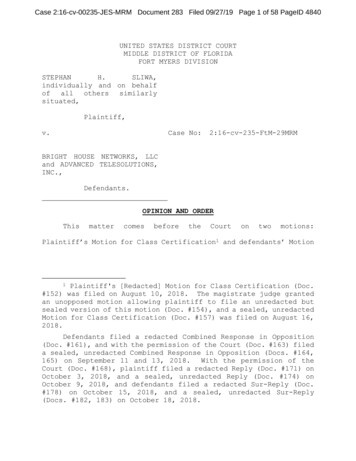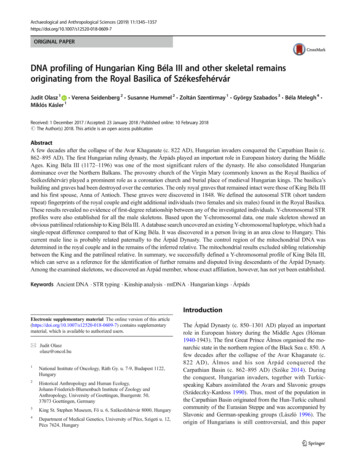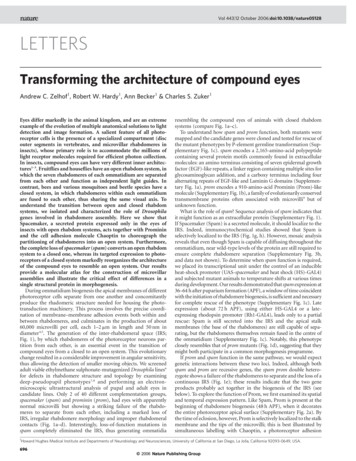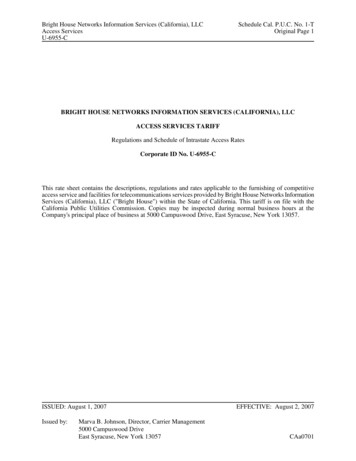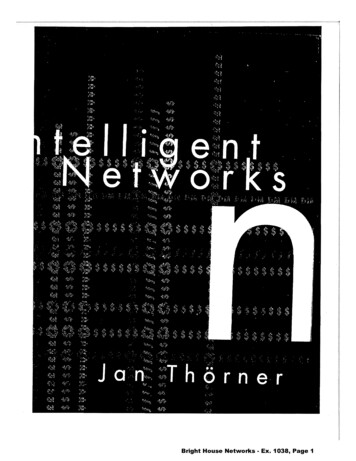
Transcription
Bright House Networks - Ex. 1038, Page 1
IIntelligent NetworksJan ThornerArtech HouseBoston LondonBright House Networks - Ex. 1038, Page 2
Library of Congress Cataloging-in-Publication DataThOrner, Janfutelligent networks/Jan Thornerfucludes bibliographical references and index.ISBN 0-89006-706-61. Telecommunication systems. 2. Telephone systems. I. Title.TK5102.5.T536 1994621.382--dc2094-15140CIPBritish Library Cataloguing in Publications DataThOrner, Janfutelligent NetworksI. Title621.38ISBN 0-89006-706-6 1994 ARTECH HOUSE, INC.685 Ca-nton StreetNorwood? MA 02062All rjghts reserved. Printed and bound in the United States of America. No part of this book may bereproduced or utilized in any form or by any means, electronic or mechanical, including photocopying, recording, or by any information storage and retrieval system, without permission in writingfrom the publisher.futemational Standard Book Number: 0-89006-706-6Library of Congress Catalog Card Number: 94-1514010 9 8 7 6 5 4 3Bright House Networks - Ex. 1038, Page 3
ContentsxiPrefacexiiiAcknowledgmentsChapter 11.11.21.31.4Building, Operating, and Using Large, Complicated SystemsLarge System Evolution Occurs in WavesLarge System DilemmaUser WillingnessThe World's Largest System114710Chapter 22.1Intelligeri.t NetworksNew Tren.ds and Network Economy are the Driving Forcesbehind Intelligent NetworksTrends in Society2.1.12.1.2Trends in TechnologyTrends in Communication2.1.3The New Natural Resources2.1.42.1.5New Trends and Economic Reasons Require a NewTelecommunication ConceptThe Intelligent Network Concept2.2.1The Intelligent Network Conceptual Model2.2.2The Introduction of Platforms2.2.3What the Intelligent Network Really Is2.2.4Applicability to All Access NetworksNetwork Service Implementation2.3.1Conventional Service Implementation2.3.2Service Implementation on Intelligent NetworksThe Evolution of Intelligent iiBright House Networks - Ex. 1038, Page 4
viiiIntelligent Networks2.4.1How It All Began2.4.2Bellcore's IN/1, IN/22.4.3Advanced IN2.4.4Capability Sets from ITU-T and ETSI2.5Intelligent Network Users: Requirements and Obligations2.5.1Service Subscribers and Service Users2.5.2Service Providers2.5.3Network OperatersThe Term "Intelligent Network" Will Not Be Used beyond2.6the 1990sReferencesPlatforms for Intelligent Networks TodayGeneral TrendsA Basic Telephone Network is a Valuable PlatformValuable Functions in an Existing Network3.3Intelligent Network Implementations with or without CCSS No.73.43.4.1Signaling Types3.4.2Common Channel Signaling System No.73.4.3Implementations that Use Service Control Points3.4.4Implementations that Use Service Switching andControl Points3 .4.5Mated Pairs of Service Control Points and ServiceSwitching Control Points3.5Telephone Traffic Theory Applied to New Services3.6Intelligent Network Management Functions3.6.1The Service Management Point3.6.2Charging, Billing,and AdministrationReferencesChapter 33.13.2Chapter 44.14.24.34.4Exploitation of Intelligent Networks in Services TodayServices Available before Intelligent Networks4.1.1General Aspects4.1.2Conventional Non-IN-Based ServicesService Implementation on Intelligent Networks4.2.1Service Creation on an Intelligent Network4.2.2Service Provisioning aud Customization4.2.3Network Introduction of ServicesThe First IN-Based Services4.3.1Basic Characteristics of Some IN-Based Services4.3.2Value-Added Features4.3.3Creating Advanced IN-Based ServicesFamilies of IN-Based 5858586061626263686974757677818387Bright House Networks - Ex. 1038, Page 5
Contents4.5Complementary Services to Intelligent NetworksReferencesChapter 55.15.2Risks and Threats Facing Intelligent NetworksIdentifying the Weak PointsSolutions to the Problems5.2.1Redundant Paths and Backup Capabilities5.2.2Local and Temporary Service Implementations5.2.3Fast Withdrawal or Temporary Closing of a Service5.2.4. Built-In Control and Supervisory Functions5.2.5Service Interworking Management ToolsNew Service Demands in the FutureTrends, Tendencies, and Demands in the 90sTowards Full Mobility in the Fixed Networks6.2.1A New User Structure6.2.2The Impact of Full Mobility on Services6.3Service Administration and Management Evolution6.3.1Service Prototyping, Testing, and Supervision6.3.2The Evoh tion of Customer Control Capabilities6.3.3Charging and Billing6.3.4Security and Reliability Demands6.4Service Interworking6.4.1Understanding the Complexity of Service Interworking6.4.2Structuring Service Interworking6.4.3Service Interaction6.4.4Solutions to the Service Interaction ProblemReferencesChapter 66.16.2Chapter 77.17.2.7.3Future Network Evolution in Harmony with Intelligent NetworksDifferent User Needs7 .1.1Service Subscribers and Service Users7 .1.2Service Providers7.1.3Network OperatorsTraffic Demands on the NetworkNetwork Traffic Solutions7.3 .1 · Priority7.3.2Redundancy on the Network7.3 .3Handshaking Functions and Acknowledgments7.3.4A Flexible and Adaptive Routing System7.3.5Encryption7.3.6Fault-Free Connections7.3. 7Overload Functions (Call Gapping, 41142142143·143144144Bright House Networks - Ex. 1038, Page 6
xIntelligent Networks7.47.57.6Chapter 88.18.28.38.4AppendixA.lA.2A.3Impact on Future Network Structure7.4.1New Network Topologies7.4.2Mated Pairs of Service Control PointsAllocation and Optimization of Resources on Networks7.5.1Resource Allocation and Optimization forAnnouncement Machines7.5.2Resource Allocation and Optimization for Service Logic7.5.3The Evolution of Resource Allocation and OptimizationInterworking between Intelligent Network PlatformsBuilding, Operating, and Using Large, ComplicatedTelecommunication NetworksLarge Intelligent Network System EvolutionIntelligent Networks Facilitate the Building of Large SystemsSolutions to the User Willingness ProblemConclusionsService-Independent Building Blocks Defined in Capability Set 1Capability Set 1 Target Set of Service FeaturesCapability Set 1 Target Set of 173175179About the Author183Index185Bright House Networks - Ex. 1038, Page 7
rrPrefaceThe worldwide telecommunication network is the greatest and most complex system thatexists. Telecommunication is one of the most important, most expansive, and most powerful tools in the 90s, in almost any business area, and it is going to play a much more important role in the private domain. Many services that, today, are provided by other media,in the 90s, will be taken over by telecommunication networks. To fulfill all the requirements this implies, a quite new approach to building, maintaining, changing, and providingservices is needed. A much quicker reaction to market demands as well as opportunities tocustomize services will be other natural consequences. The solution to fulfilling all thoserequirements is intelligent networks (IN), a concept that was introduced in the 80s and willbe widely used in the 90s in .all networks.The first phase of intelligent network implementation is more a new way of thinkingor of structuring than a new network. The basic functionality in intelligent networks, theservice control function (SCF), which hosts the control (or the intelligence) for handlingservices, will be implemented in service control points (SCPs) or in service switching andcontrol points (SSCPs). Before intelligent networks, this functionality was spread to several nodes in the network, for example, for. a freephone number (i.e., 800 number). So, normally, when IN is introduced into a network, it brings about not a sudden increase in totalnetwork intelligence, but rather a new structuring of the already existing one. An increasein intelligence occurs first in the subsequent phases of intelligent network implementation,when such features as mobility, flexibility in charging and billing, advanced customer control facilities, and advanced routing are introduced. These enhancements would, however,not be possible without the new structuring introduced in the first phase.It is not a coincidence that the intelligent network concept was born in the 80s andnot before. It was in the 80s that networks reached, on a widespread scale, the level oftechnology required for intelligent networks to be introduced, namely, a broad usage ofstored program control (SPC) exchanges, digital transmissions, and modem signaling systems like the Common Channel Signaling System (CCSS) No.7.XlBright House Networks - Ex. 1038, Page 8
xuIntelligent NetworksThe goal of this book is to provide a broad knowledge of intelligent networks, by exploring both the theoretical models of the International Telecommunication Union (ITU-T)(auhunn 1993) and the practical experiences of implementing an intelligent network on areal network. Theoretical discussions accompany examinations of the impact of networkimplementation. User-related aspects of the intelligent network, from the subscribers', theservice providers', and the network operators' views, are covered. The book examines theadvantages of using intelligent networks as well as the risks to be faced. It also attempts todescribe what intelligent networks represent in the long term-a flexible intelligence forany access form and any network.Chapter 1 defines two major problems facing all networks in the 80s and 90s: (1) updating software in large, complex systems, like a telephone network, and (2) increasing theuse of existing services. Chapter 2 takes a more general look at the intelligent networkconcept, including both practical issues and standardization in ITU-T and ETSI. The chapter also discusses the likely future of intelligent networks. Chapter 3 describes various network implementations of intelligent networks as well as the charging and billing functions.Chapter 4 describes the services available in the first years of intelligent networks, including services outside the intelligent network platform. Chapter 5 explores the risks andthreats to intelligent networks that implementers face if they are not careful. Chapter 6takes a step into the future and considers some new services and functions that will develop as a result of user demands: enhanced mobility, service interworking, and chargingand billing. Chapter 7 examines the impact of new services on future IN platforms. Resource allocation and mobility are covered as well. The chapter also discusses the variousways that cooperation between intelligent network platforms can be accomplished. Finally,Chapter 8 speculates on how intelligent networks can help solv·e the problems raised in·Chapter 1.Bright House Networks - Ex. 1038, Page 9
AcknowledgmentsThis book would have been much more difficult to write without the support I receivedfrom my employer, Telia, and from all my colleagues there. I want to thank Telia for its financial support and thank all my colleagues, who have been involved in one way or another, for their encouragement and support. However, the ideas and opinions expressed inthe book are entirely my own and are not meant to reflect the policy, position, or opinionofTelia.I also want to thank the International Telecommunication Union-TelecommunicationStandardization Bureau (ITU-T) for allowing me to use two figures and a table for whichthey are the copyright holder (Figures 2.1 and 2.2 and Table A.l ). The choice of this material is my own and therefore not the responsibility ofiTU-T in any way.xiiiBright House Networks - Ex. 1038, Page 10
Chapter 1Building, Operating, and Using Large,Complicated Systems1.1 LARGE SYSTEM EVOLUTION OCCURS IN WAVESDefining a large system is always difficult. Nevertheless, a large system can be describedas a system that possesses at least one of these characteristics: Requires considerable software to operate it,Is extremely complex, ·Covers a large geographic area,Contains a large number of users.Additional criteria for describing large systems may exist, but these are generally the firstcharacteristics that come to mind.Some large systems are standalone systems, complete with built-in, independent intelligence. These systems may and often do communicate with other systems, but theirmain characteristic is that they are able to work autonomously, without intervention from .the outside world. Excellent examples include airplanes, ships, and space shuttles, all ofwhich are very complex systems that have nearly all control logic or intelligence on board.Other systems feature distributed intelligence, whereby a single piece of equipmentis only a small part of a larger, complex system. The entire system works by regulated cooperation among all the equipment inside, and, more importantly, it often runs in an operation mode that does not allow the whole system to be taken down for a change ofhardware, testing, or another reason. The best example, of course, is the worldwide telecommunication network. A telecommunication network must function 24 hours a day, 365days a year, which means that maintenance and improvements to the system must be carried out during operation.Looking back at the evolution of large systems, an interesting phenomenon can beobserved: large systems tend to evolve in waves (or follow a distinct wave form).1Bright House Networks - Ex. 1038, Page 11
2Intelligent Networks A time to sow (spring). Phase one is the investment in and development of a basicsystem (a platform). In this phase, no results are visible but considerable amounts ofmoney are normally spent. A time to reap (autumn). In phase two, investments must be exploited to earn backthe money spent during phase one. This is also the phase in which visible. results areproduced, and the money required to maintain the system is less than the moneyspent in phase one. A need to sow (spring) again. There will come a time, however, when we can nolonger continue to run the existing system (existing platform) because it is becomingold-fashioned. Consequently, we must open our wallets again to invest either in improving the existing system or in developing a completely new one.Consequently, the cycle starts all over again. (See Figure 1.1.)Up-to-datefactorIIIII.IIIIIIIBelow thislevel thesystem isold-fashionedFigure 1.1 Large systems evolve in waves.Bright House Networks - Ex. 1038, Page 12
Building, Operating, and Using Large, Complicated Systems3The system becomes old-fashioned because general demands increase as the technical evolution continues, and new systems are constructed with greater capabilities. Thismeans that the original system becomes less modem; in other words, the up-to-date factorof the system continuously decreases. Once it falls below a certain low level, the systembecomes a liability rather than an asset to its owner. Ideally, an organization should upgrade a system or replace it with a new one before the system becomes a liability. However, if the system is large and complex, this is a very expensive and time-consuming task.In reality, most systems experience a period, before they are upgraded or replaced, whenthey are more of a liability than an asset.Obviously, this discussion is applicable to telecommunication networks. To understand that it can be considered a common trend, we need only look at the U.S. spaceprogram: During the 50s and 60s, large sums of money were spent building up a basic systemthat would enable human beings to leave the confines of earth. The first visible triumphs, for the general public, were the first successful launch ofan unmanned rocket, which occurred around 1960; followed some years later by thefirst manned space flight; and the landing of a man on the moon in 1969. In betweenthose events, a large amount of effort was expended, but it was not visible to thegeneral public. In the 70s and part of the 80s, the basic system was improved. The next visible triumphs were the ability to reach other planets and the space shuttle, which provided a system that could be used more than once.Telecommunication networks also evolve in waves,from the technological point ofview, beginning with stored program control (SPC) technology in the 70s, followed by fiber optics and the integrated service digital network (ISDN) in the 80s, and continuingwith intelligent networks and broadband in the 90s. However, this technological progress,where a large amount of money is spent, is not perceived directly by the user.From the 60s to the 70s, the most v sible advancement in telecommunication,from asubscriber point of view, was a more reliable network. During the 70s, value-added services, for example, call forwarding and call transfer services, became available in privateautomatic branch exchanges (PABXs); during the 80s, these services were also availablein public networks. Services like freephone (800 numbers) and 900 numbers became available in the public networks in the 80s and 90s (often built first with node-based solutionsand not with intelligent network platforms). In the near future, services offered via broadband access will be generally spread among subscribers.Features visible to the general public are one thing; results that constitute the evolution of a large system are another. Just because results do not become visible at once doesnot mean that work is not proceeding. In fact, it is often quite the opposite; by the time results become visible, the work is almost completed.Bright House Networks - Ex. 1038, Page 13
4Intelligent Networks1.2 LARGE SYSTEM DILEMMAThe dilemma of a large system often becomes apparent in attempts to improve its functionality. Users (both providers and customers) of a system have one single overall requirement: to have the best functional system available at any moment.We must consider three major factors when contemplating improving an existingsystem:1. The cost of improving the system. Because the complexity of a system increaseswith each improvement, the cost of making a similar improvement tends to risemore and more each time. (See Figure 1.2.) For example, changing a number planin one area will become more difficult and more expensive as the number ofsubscribers in the area increases.2. The existing system itself. The fact that they must improve an existing systeminstead of building a new system from scratch often poses great problems forproject managers. Typically, the existing system was built using old technologyand old interfaces, making compatibility a major headache. Consequently, theexecution of a project can seldom follow a straightforward approach to the finalgoal.3. The technical evolution in general. The continuously accelerating speed oftechnological evolution leads to, among other things, Increasingly shorter intervals between technology generations available on themarket, Increasingly shorter time before an operational system becomes outdated.The life cycle of a large system can be divided into three phases (see Figure 1.3):a) The time it takes a vendor to update an existing system or develop a newone, or the time it takes a customer to search for, evaluate, and install asystem. (Ta)b) The interval during which a system fulfills user requirements. (Tb)c) The interval during which the system is still in operation but no longerfulfills user requirements. (Tc)If Tg represents the time between the birth of two consecutive technology generations that are applicable to a given system, the following assumptions concerning evolution and user needs can be made (see Figure 1.4):1. The faster technology and user needs evolve, the faster we need new systems andthe faster a system becomes old-fashioned. This means that both Tg (generationBright House Networks - Ex. 1038, Page 14
Building, Operating, and Using Large, Complicated Systems5TotalinvestmentCost ofstep 2Cost ofstep 1StepStep 3 IIIIIIItBasicsystemTime /Comparablesteps ofimprovementFigure 1.2 The cost of improving an existing system.time gap) and Tb (productive time span) will continuously decrease with eachnew generation of systems.2. The system becomes more complex, that is, it contains a growing number of newfunctions with each new generation. At the same time, the number of generationsthat are simultaneously in operation grows. Both of these conditions result in anincreasingly longer development time for the vendor and an increasingly longerevaluation and installation time for the customer for each new generation ofsystems: Consequently, Ta (the development/evaluation and installation timespan) will continuously increase.Bright House Networks - Ex. 1038, Page 15
Intelligent Networks6The systemgoes out ofoperationDevelopmentof thesystem startsThe systemgoes intooperation1Ta1TcTbTime,.Figure 1.3 The life cycle of a large system.Time0TbTc- - - -Tb2Tc3Tc4I .:.Syotemgeneration!Figure 1.4 The evolution of system generations.IIBright House Networks - Ex. 1038, Page 16
Building, Operating, and Using Large, Complicated Systems7If we look at Figure 1.4, two very interesting questions arise.1. What if Ta reaches the same length as Tb, that is, what if the development time orthe time required to update a system is as long as the time the system fulfills userrequirements?2. What if Tg becomes less than Ta (as in system generation 4 in Figure 1.4), thatis, what if new generations of systems appear faster than the time required todevelop them?If we do not change the way we work, we will be faced with what I refer to as theLarge SYstem Dilemma, or LSYD. If we do not find a solution to LSYD, we will not beable to continue expanding and evolving systems beyond a certain size, which would bereached very soon.As can be inferred from these two questions, the key factor is Ta, that is, the time required to develop and deploy a new system or to update an existing system to fulfill newrequirements. Accordingly, we should be very interested in searching for a way to decrease Ta.Fortunately, such a way exists within the telecommunication area, namely the use ofthe intelligent network concept. Intelligent networks allow us to decrease one of the mostimportant factors required to upgrade a system to meet user requirements: the time required to introduce new services when demanded. With intelligent networks, the introduction time for a new service is decreased from about two to five years, using conventionalsoftware programming and testing, to a number of months. (This is further discussed inChapter 8.)1.3 USER WILLINGNESSThe basic point of introducing value-added services is to provide extra value for the userand greater revenues to service providers and network operators. These goals are best accomplished by making it easier for subscribers to use their telephone and by enabling different business areas to benefit from using telecommunication services. Put simply, thecost of setting up a telephone call is the same to the network operator, whether the call issuccessful or not, except that no income is generated in the latter case. The subscribermight also find it frustrating not to reach a called party, getting a busy signal or no replyinstead.If "intelligent" services are introduced to raise the share of completed calls, all parties will profit. That is why all networks give high priority to services resulting in call accomplishment (the calling party really reaches the called party). Examples of servicesinclude call forwarding unconditional, remote control of call forwarding, call forwarding ifno reply or busy, call completion to busy subscriber, services supporting mobility, andservices using time and origin control. Obviously, these services are also highly suitablefor most business areas.Bright House Networks - Ex. 1038, Page 17
8Intelligent NetworksBut, to make efficient use of a network possessing all these interesting features, subscribers must have a good user interface, which is not the case today. The user interface forthe world's largest system, the telephone network, remains dreadfully primitive. We stilluse a star, a pound sign, and the numbers 0-9 (see Figure 1.5): This is, in fact, technologyfrom the 60s in a system for the 90s.Figure 1.5 The dual-tone multifrequency (DTMF) user interface.The following hypothetical situation, involving a network operator and a customer,illustrates the antiquated nature of current terminal technology and also suggests how customers can be encouraged to use the network. Today the network operator tells a customer, "We have now created a number ofservices. Please use them!" The customer doesn't see all the possibilities offered by the network and replies,"The star and the pound sign are for call forwarding, aren't they? Actually, I neveruse call forwarding." The network operator ponders this and comes up with an idea. "Let's create somewhat more intelligent terminals, where the names of the most common services havetheir own buttons. This will surely make the terminals more user-friendly, whichwill increase the use of the services." (Figure 1.6.) But, the next time they meet, the customer replies, "It does look good, but I can't seeany use for those services in my business." The network operator goes home and considers it again. After that, he engages anadviser to help him better understand and respond to the needs of the customer. Theresults is services that correspond exactly to the needs of the customer.Bright House Networks - Ex. 1038, Page 18
Building, Operating, and Using Large, Complicated Systems9 The network operator meets the customer. "At last, we have exactly the networkservices you need for your business." But the answer is not what the network operator expected. The customer replies, "Yes, it certainly seems good, but I already havespecial routines for this, and you know how difficult it is to change them. It wouldalso cost me a lot of money and time, and my staff wouldn't like to change theirworking routines right now, as we are in the middle of a very busy .Callforwardingno reply1/'r----f/Callcompletionto busysubscriber'I'Callforwardingbusy ·vFigure 1.6 A more user-friendly interface.What is the problem here? We know that1. The user interface is good, and2. The services are exactly what the customer needs.The answer is that the customer is not motivated to change routines and begin using thetelecommunication services. Something is missing, something I call: user willingness(UW).Customers require more than good technological solutions to their demands (that is,more than a good user interface and good services), they must be convinced by a networkoperator of the advantages of particular services to be motivated to use them. Furthermore,they need assistance to switch from old routines to new ones, and such help should probably be provided by a network operator.Naturally, to create UW, the user interface must be a good one and requested services must be 100% fulfilled. But these efforts are obviously not enough. Exactly how UWis created is discussed in Section 8.3. For now, we will only observe how very different thesituation would be the next time they met if the network operator did succeed in creatingUW in the customer. This time the initiative will come from the customer.Bright House Networks - Ex. 1038, Page 19
10Intelligent Networks The customer: "You know, call forwarding works fine, but I would also like to haveremote control of call forwarding, and I would like it to work in the foiiowing manner . When can you provide this?" And, upon meeting a colleague, the customer wiii say, "You know, by using the telecommunication service call forwarding, I have increased sales by and reducedinternal costs per unit sold by ."1.4 THE WORLD'S LARGEST SYSTEMSection 1.1 identified four criteria of a large system. We can now see that the worldwidetelecommunication network possesses ail four characteristics. The network Requires considerable software,Is extremely complex,Covers a large geographic area,Contains a large number of users.The worldwide telecommunication network is undoubtedly the world's largest system, and it is no coincidence that considerable efforts have been made to solve the LSYDwithin telecommunication. As Section 8.2 discusses, the introduction of the inteiiigent network concept is one important step towards a solution.Very soon, inteiligent networks wiii offer a much wider range of services, in everynetwork, than was previously possible. The next logical step, therefore, is to focus greaterefforts on increasing the use of services introduced by creating both user-friendly interfaces and, of course, UW.Bright House Networks - Ex. 1038, Page 20
Chapter 2Intelligent Networks2.1 NEW TRENDS AND NETWORK ECONOMY ARE THE DRIVING FORCESBEIDND INTELLIGENT NETWORKS2.1.1 Trends in SocietyAs professionals, we spend a great deal of time establishing and maintaining contacts withother people, no matter what our occupation is. We meet people face to face during meetings, at the office, or in town, or communicate via telephone, telefax, computer mail, andso on.As private individuals, we maintain contacts with relatives, friends, governmentauthorities (local and central), as well as with shops, stores, and other suppliers of what weneed to live comfortably.If we look back 50-100 years, our lives were quite different in many ways. One ofthe most important basic developments that lifted our standard of living and quality of lifewas the availability of a fast and reliable telecommunication network, which, compared toother communication media, is significantly less expensive to use.A person who lived and worked in the United States or Europe 70 years ago maintained some sort of regular contact with an average of, perhaps, 100 people. Today, thatnumber is close to 500. Moreover; 80-90% of those people, 70 years ago, probably livedwithin 10 miles of each other. Today, 80-90
Artech House Boston London Bright House Networks - Ex. 1038, Page 2. Library of Congress Cataloging-in-Publication Data ThOrner, Jan futelligent networks/Jan Thorner fucludes bibliographical references and index. ISBN -89006-706-6 1. Telecommunication systems. 2. Telephone systems. I.
